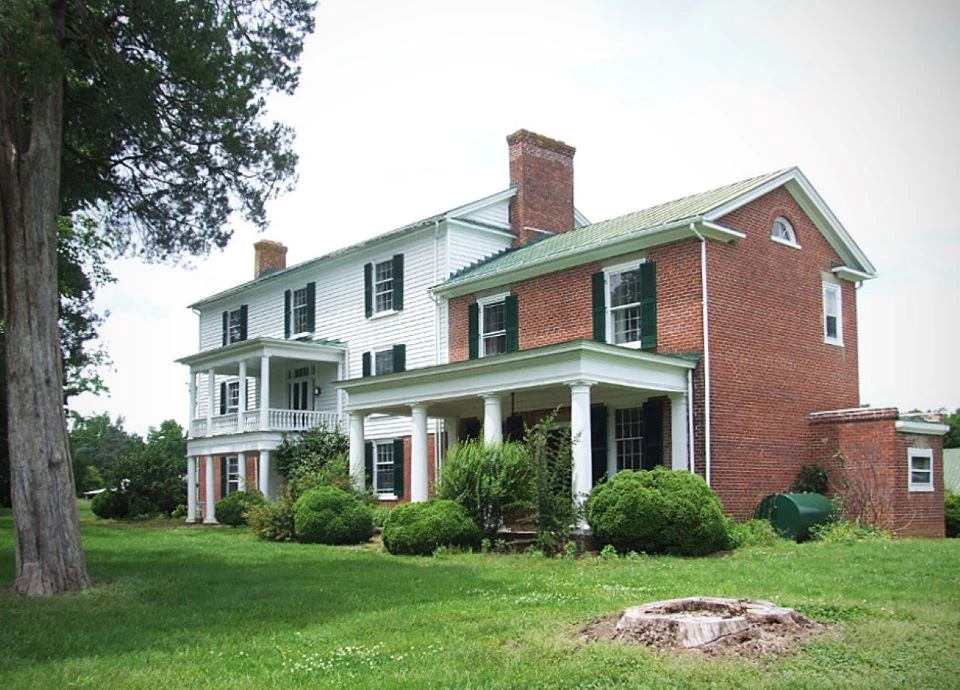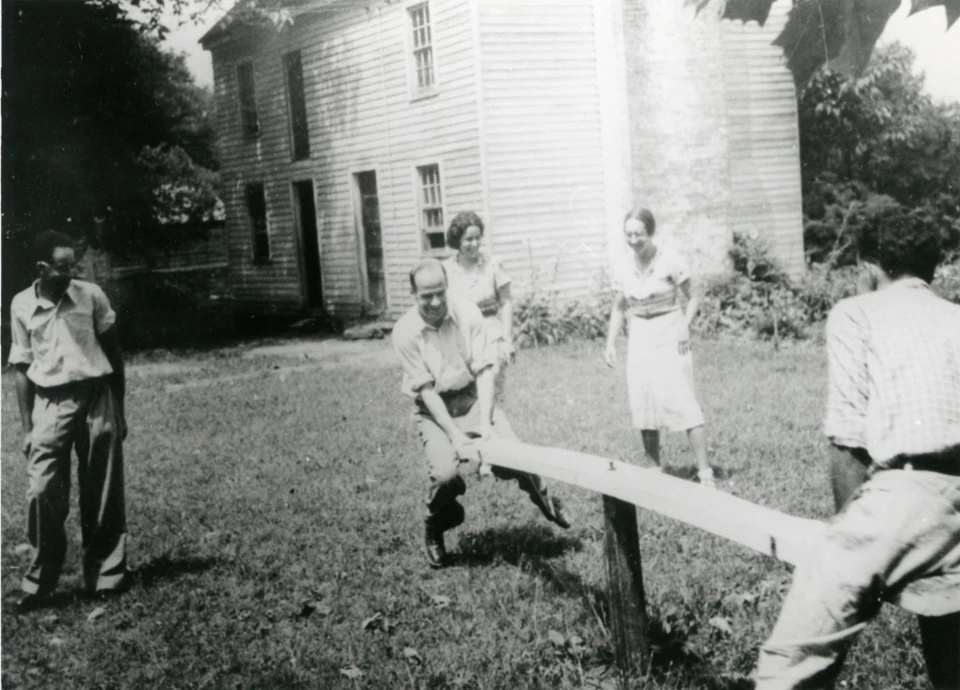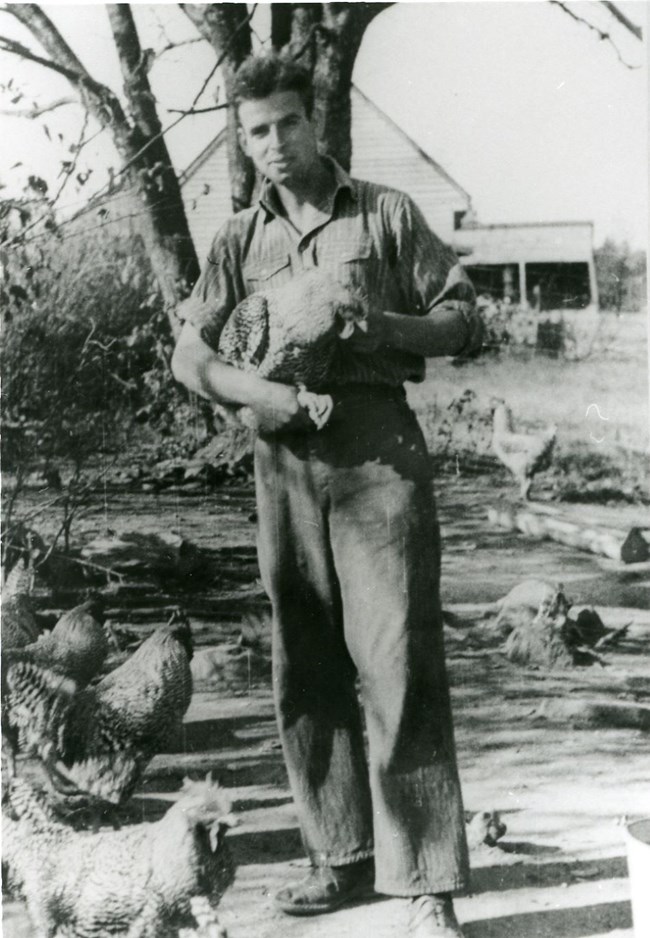Last updated: December 16, 2024
Article
History and Hope: Hyde Park Historic District, Burkeville, VA: Creating Climate Hope through Community Aid


Left image
Hyde Park’s Main House in 2009. Listed in the National Register of Historic Places in 2013.
Credit: Photograph by David A. Brown, located in National Register of Historic Places Form: Hyde Park.
Right image
Recreation Time. [Hyde Park Farm, circa 1939-1940]
Credit: Courtesy Eva Loew Family, Virginia Holocaust Museum.
Hyde Park’s transformation involves changes in its buildings, farmlands, and inhabitants. It is a history of communities working together to confront challenges and shift a site from one of pain to one of hope. Things we can learn from Hyde Park’s history of community collaboration during times of danger can be applied to challenges of climate change today.
Questions to Consider
When we face danger or challenges, how can the spaces around us become sources of support and resilience? How can we help each other when we are faced with extreme danger?Beginnings
Before the land became Hyde Park, it was home to the Nadowa tribe of the Iroquois Nation. English settlers began to inhabit Nottoway County in the 1700s. John A. Fowlkes built the main structure of Hyde Park on this land between 1762 and 1782. The Fowlkes family operated a tobacco plantation, which they maintained through slavery. After the Civil War, records show that five formerly enslaved men remained on Hyde Park as tenant farmers. [1] Tenant farming continued under various owners until the 1930s.William H. Thalheimer
William H. Thalheimer was a Jewish American businessman from Richmond, Virginia. After a business trip to Germany in 1930, he became invested in helping Jewish refugees escape. He was not alone in this mission. Jewish American community groups organized projects which involved obtaining visas and finding communities where refugees could resettle. Relocation efforts depended heavily on community-based action because the U.S. government was not sufficiently supporting Jewish refugees. [2]Hyde Park relocation efforts began in 1938, after Thalheimer purchased the farm. The same year, he was connected with Dr. Curt Bondy, who had been working to protect Jewish Germans in Germany. Thalheimer was the national Chairman of the Refugee Resettlement Committee of the National Coordinating Committee. This group was part of a larger refugee aid organization, the National Refugee Service. The NRS was financed through fundraising efforts by the Jewish community. Thalheimer believed that rural areas would serve as safe places for refugees.
In 1944, the United States government established the War Refugee Board (WRB). This board served as the official government attempt at intervention. Even after the foundation of the WRB, the Jewish community remained involved in the refugee process. Over 90% of the Board’s funding came from Jewish American groups. [3]
Similar ideas about providing safety to Jewish German citizens were already occurring in Germany. The Nuremburg Laws were passed in 1935. This legislation discriminated against Jewish Germans by removing their citizenship, instead making them “subjects” of the state. It eventually extended to Romani and Black Germans, categorizing them all as “racial aliens.” [4] As a response, Bondy established Gross-Breesen, an agricultural school for Jewish youth aged 15 to 17, in Silesia, Germany.
At Gross-Breesen, lessons were designed to make emigration and acclimatizing to new countries easier. The agricultural program lasted two years. Gross-Breesen aimed to build the students’ character while developing skills to overcome strict immigration laws and difficulties obtaining employment in a new country [5].
Community Efforts and Adapting to Climate Change
In Germany and the United States, people worked together to find relocation-based solutions to the threat of the Holocaust. Today, climate change requires similar community efforts. There are many ways that people will have to adapt to a changing climate. Individual or community relocation is one of them. According to a 2021 White House report, extreme weather events and conflict displace almost 30 million people every year. Climate change does not affect every community equally. [6] Groups that are already vulnerable because of economic or resource scarcity may face more extreme impacts. As part of our shared fight against climate change, it is important to find ways to support those who will find themselves displaced.The fundraising and resource-locating efforts of American Jewish communities made German Jewish emigration to the United States possible. After purchasing Hyde Park, Thalheimer began the task of obtaining Visas for 25 students. This presented urgent challenges in America and abroad.
Hyde Park Farmlands: The “Dream Farm” and International Community
The first Gross-Breesener at Hyde Park, Ernst Loewensburg, arrived in June 1938. One more student, Henry Cornes, arrived later that fall. It took Thalheimer over a year to negotiate with the State Department for the remaining 23 visas. To avoid the restrictions placed on German Jewish immigration, Thalheimer provided each of the students with shares of the farm. This made them landowners and removed suspicion that they would be temporary laborers. [7]The Gestapo’s raids on Gross-Breesen occurred during the same time as Thalheimer’s negotiations. All males over 18 at the farm were sent to Buchenwald Concentration Camp. Upon the condition that they left Germany immediately, all Gross-Breeseners were released from the camp. Several people collaborated to provide the Gross-Breeseners at Buchenwald a quick escape from the country. An escaped Gross-Breesener in Holland was able to produce paperwork for those selected to work in Hyde Park. Thalheimer was able to provide Bondy with a visa that included a teaching contract in Richmond. Twenty-two students and Bondy joined the earlier refugees at Hyde Park. Other community groups provided relocation opportunities on an international scale. In total, an estimated 158 of the 266 total Gross-Breesen trainees were able to leave Germany. [8]

Courtesy Eva Loew Family, Virginia Holocaust Museum.
To maintain a sense of community, Bondy established Rundbriefe (“Circular Letters”). This newsletter compiled reports from Gross-Breesen students around the world. It began as a way to share updates on the different farming practices and technologies at each of the sites. Eventually, the letters became ways for the students to compare their experiences with new communities. [10] As World War Two continued, they discussed the ways that it shaped their lives.
Often a space to share in grief and loss, the newsletters also offered hope. Bondy encouraged its continuance in the post-war era. The students continued publishing Rundbriefe from 1940 to 2006. Newsletters began to include updates on the students’ adult lives as well as coverage of international reunions between 1984 and 2005. Bondy believed that his students could have an impact on their new countries because of the lessons taught at Gross-Breesen. He argued it was important to use their principles and skills to continue working against injustice. [11]

Courtesy Eva Loew Family, Virginia Holocaust Museum
Social Cohesion as a Tool for Adapting
Hyde Park's legacy of community involvement can help shape our responses to climate adversity today. Climate change adaptation is a key tool outlined in the Fourth National Climate Assessment. It involves taking action at individual, local, regional, and national levels to reduce the effects of climate change. Adaptations can be social. The National Climate Assessment defines social cohesion as the way members of a community identify with the group and each other. Increased social cohesion improves ability to adapt and recover from environmental disasters. [12]For the Gross-Breeseners, shared practices like the Rundbriefe newsletters helped maintain their identities. Communicating with each other about grief, hope, and changes increased the social cohesion among the displaced students. Even after the war ended, the continued bond and communication encouraged the students to fight other, contemporary injustices. Today, it is important to identify the cultural and social practices that make our communities strong and adapt them to climate change.
Hyde Park after the Gross-Breeseners
In Febuary 1941, Gross-Breeseners closed the Hyde Park Farm. By April 1941, all of the students had found employment or enlisted in the United States army. Many Gross-Breeseners who joined the military served as intelligence officers. They used their knowledge of German culture to serve at high levels. Others became farmers, teachers, and nurses. [13] Although Hyde Park Farmlands, Inc. dissolved, both the students who came of age and the farm site continued to serve the community.Taking Action
The story of Hyde Park, William Thalheimer, and the Gross-Breeseners is one of ordinary people working together to stop injustice and extreme danger. As Jewish American groups assisted refugees displaced by hate, Americans today need to prepare themselves to assist climate refugees. Furthermore, the connection the Gross-Breeseners maintained through their newsletters is an example of the power of communication during adversity. To successfully adapt to climate change today, we need to strengthen and maintain community ties.Timeline: Hyde Park, VA and Gross-Breesen Site Transformation
Germany Timeline
| 1930 | Thalheimer visits Berlin on a business trip. The antisemitism he sees and experiences drives him to find ways to help German Jews relocate. |
| 1935 | The Nuremburg Laws revoke the citizenship rights of Jewish, Romani, and Black Germans. Dr. Curt Bondy founds Gross-Breesen Agricultural school in Silensia. The farm’s goal is to build the character of its Jewish students while making emigration and resettlement easier. |
| 1938 | Kristallnacht occurs. All male Gross-Breeseners over 18 are sent to Buchenwald Concentration Camp. |
US Timeline
| 1938 | Thalheimer and Bondy meet, and Thalheimer purchases Hyde Park. He begins the process of obtaining a total of 25 visas for Gross-Breeseners and Bondy. The first two students arrive, but there is a delay on the remaining 23 visas. |
| 1939 | Thalheimer receives the remaining visas. In total, 22 Gross-Breeseners and Bondy emigrate to Hyde Park. |
| 1941 | Hyde Park Farmlands, Inc. dissolves. The farm is converted into housing for the families of WWII soldiers stationed at nearby Fort Pickett. |
| 1942 | The State Department receives definitive proof of the Holocaust. |
| 1944 | After public pressure, the War Refugee Board is founded. The government establishes the only federally-operated refugee camp for Jewish Germans at Fort Ontario. |
This article was written by Emma Gruesbeck, an intern at the Cultural Resources Office of Interpretation and Education, through a cooperative agreement with the National Council of Preservation Education (NCPE).
Notes and Bibliography
[2] David S. Wyman and Charles H. Rosenzveig, The World Reacts to the Holocaust (Baltimore: Johns Hopkins University Press, 1996), 703-5, Terry Menefee Gau, “Virginia’s hidden history: Hyde Park Farm & the Holocaust,” VPM, October 20, 2022, https://www.vpm.org/2022-10-20/virginias-hidden-history-hyde-park-farm-and-the-holocaust.
[3] Ibid., Robert H. Gillette, The Virginia Plan: William B. Thalheimer & a Rescue from Nazi Germany (The History Press, 2011).
[4] Sheer Ganor, “To Farm a Future: The Displaced Youth of Gross-Breesen,” in German Historical Institute Bulletin Supplement 15: “Histories of Migrant Knowledge: Transatlantic and Global Perspectives” (2020), 19-40, Wyman and Rosenzeig, The World Reacts to the Holocaust, “Nuremburg Race Laws,” United States Holocaust Memorial Museum, last edited September 11, 2019, https://encyclopedia.ushmm.org/content/en/article/nuremberg-laws.
[5] Ganor, “To Farm a Future.”
[6] “Report on the Impact of Climate Change on Migration,” The White House, October 2021, https://www.whitehouse.gov/wp-content/uploads/2021/10/Report-on-the-Impact-of-Climate-Change-on-Migration.pdf.
[7] Gau, “Virginia’s hidden history,” Bill Lohmann, “German students visit Nottoway farm that was a safe haven for German Jewish refugees in the late 1930s,” Richmond Times-Dispatch, October 14, 2014, https://richmond.com/german-students-visit-nottoway-farm-that-was-a-safe-haven-for-german-jewish-refugees-in/article_d84efd31-a5d0-5736-a784-351cb79d2e63.html.
[8] Ganor, “To Farm a Future,” 26-28. Gau, “Virginia’s hidden history,” Lohmann, “German students visit Nottoway Farm.”
[9] Gau, “Virginia’s hidden history,” Lohmann, “German students visit Nottoway Farm,” “Brief 7-p378-’40 - Gross Breesen Silensia,” Yumpu, uploaded December 23, 2012, 344, https://www.yumpu.com/de/document/view/6525341/9-brief-7-p378-40-gross-breesen-silesia, "Built by German Refugees, 'Dream' Farm Sold Again," Richmond News-Leader, April 19, 1941.
[10] Ganor, “To Farm a Future.”
[11] Ibid, 33-37.
[12] R. Lempert et al., “Reducing Risks Through Adaptation Actions,” in Impacts, Risks, and Adaptation in the United States: Fourth National Climate Assessment 2 (2018), 1309–1345. doi: 10.7930/NCA4.2018.CH28.
[13] Gau, “Virginia’s hidden history,” Lohmann, “German students visit Nottoway Farm," Overton McGehee, “A retreat now, inn was once a refuge,” Richmond Times-Dispatch, May 8, 1988.
“Brief 7-p378-’40 - Gross Breesen Silensia.” Yumpu, uploaded December 23, 2012. https://www.yumpu.com/de/document/view/6525341/9-brief-7-p378-40-gross-breesen-silesia.
Brown, David, Stephen Fonzo, Thane Harpole, and Emilie Johnson. “National Register of Historic Places Registration Form: Hyde Park.” NPGallery. National Park Service, May 28, 2013. https://npgallery.nps.gov/NRHP/AssetDetail/c745c037-c56e-4a55-9720-5d90a57acf6a
Ganor, Sheer. “To Farm a Future: The Displaced Youth of Gross-Breesen.” German Historical Institute Bulletin Supplement 15: “Histories of Migrant Knowledge: Transatlantic and Global Perspectives” (2020): 19-40. bgh651s02.indd (ghi-dc.org)
Gau, Terry Menefee. “Virginia’s Hidden History: Hyde Park Farm & the Holocaust.” VPM, October 20, 2022. https://www.vpm.org/2022-10-20/virginias-hidden-history-hyde-park-farm-and-the-holocaust.
Gillette, Robert H. The Virginia Plan: William B. Thalheimer & a Rescue from Nazi Germany. The History Press, 2011.
Lee, Robert E. Letter to Mrs. Paschal J. Fowlkes. Richmond, Library of Virginia. 25681. September 17, 1864.
Lempert, R. et al. “Reducing Risks Through Adaptation Actions.” Impacts, Risks, and Adaptation in the United States: Fourth National Climate Assessment 2 (2018): 1309–1345. doi: 10.7930/NCA4.2018.CH28.
Lohmann, Bill. “German students visit Nottoway farm that was a safe haven for German Jewish refugees in the late 1930s.” Richmond Times-Dispatch, October 14, 2014. https://richmond.com/german-students-visit-nottoway-farm-that-was-a-safe-haven-for-german-jewish-refugees-in/article_d84efd31-a5d0-5736-a784-351cb79d2e63.html.
McGehee, Overton. “A retreat now, inn was once a refuge.” Richmond Times-Dispatch, May 8, 1988. https://richmond.newspapers.com/article/richmond-times-dispatch-hyde-park-va-gl/156119141/.
Nottoway County Personal Property Tax Records (microfilm). Richmond, Library of Virginia.
“Report on the Impact of Climate Change on Migration.” The White House, October 2021. https://www.whitehouse.gov/wp-content/uploads/2021/10/Report-on-the-Impact-of-Climate-Change-on-Migration.pdf
Wyman, David S. and Charles H. Rosenzveig. The World Reacts to the Holocaust. Johns Hopkins University Press, 1996.
